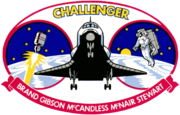STS-41-B

Bruce McCandless demonstrates the Manned Maneuvering Unit (MMU), floating in space above a clouded Earth.
|
|
| Mission type | Satellite deployment Equipment testing |
|---|---|
| Operator | NASA |
| COSPAR ID | 1984-011A |
| SATCAT no. | 14681 |
| Mission duration | 7 days, 23 hours, 15 minutes, 55 seconds |
| Distance travelled | 5,329,150 kilometres (3,311,380 mi) |
| Orbits completed | 128 |
| Spacecraft properties | |
| Spacecraft | Space Shuttle Challenger |
| Launch mass | 113,603 kilograms (250,452 lb) |
| Landing mass | 91,280 kilograms (201,238 lb) |
| Payload mass | 12,815 kilograms (28,252 lb) |
| Crew | |
| Crew size | 5 |
| Members |
Vance D. Brand Robert L. Gibson Bruce McCandless II Robert L. Stewart Ronald E. McNair |
| EVAs | 2 |
| EVA duration | 12 hours, 12 minutes First: 5 hours, 55 minutes Second: 6 hours, 17 minutes |
| Start of mission | |
| Launch date | February 3, 1984, 13:00:00 UTC |
| Launch site | Kennedy LC-39A |
| End of mission | |
| Landing date | February 11, 1984, 12:15:55 UTC |
| Landing site | Kennedy SLF Runway 15 |
| Orbital parameters | |
| Reference system | Geocentric |
| Regime | Low Earth |
| Perigee | 307 kilometres (166 nmi) |
| Apogee | 317 kilometres (171 nmi) |
| Inclination | 28.5 degrees |
| Period | 90.8 minutes |
| Epoch | February 5, 1984 |
 L-R: Seated, Vance Brand, Commander, Robert Gibson, Pilot. Standing, L-R: Mission Specialists Robert L. Stewart, Ronald McNair and Bruce McCandless. Stewart and McCandless are wearing extravehicular mobility units (EMU). |
|
STS-41-B was the tenth NASA Space Shuttle mission and the fourth flight of the Space Shuttle Challenger. It launched on February 3, 1984, and landed on February 11 after deploying two communications satellites. It was also notable for including the first untethered spacewalk.
Following STS-9, the flight numbering system for the Space Shuttle program was changed. Thus, the next flight, instead of being designated STS-11, became STS-41-B; the original successor to STS-9, STS-10, was cancelled due to payload delays.
Seats 5–7 are on the Middeck.
Challenger lifted off from Kennedy Space Center at 8 am EST on February 3, 1984. Two communications satellites were deployed about 8 hours after launch; one, Westar 6, was for America's Western Union, and the other, Palapa B2, for Indonesia. However, the Payload Assist Modules (PAM) for both satellites malfunctioned, placing them into a lower-than-planned orbit. Both satellites were retrieved successfully in November 1984 during STS-51-A, which was conducted by the orbiter Discovery.
...
Wikipedia

